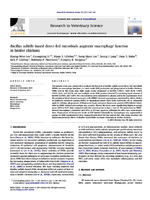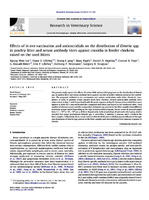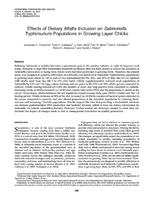Items tagged "poultry nutrition": 30
Foregoing Sub-therapeutic Antibiotics: the Impact on Broiler Grow-out Operations
We use data from a recent national survey to analyze the use of sub-therapeutic antibiotics (STAs) among broiler growers. We estimate that 42% of growers do not use STAs in their feed or water, and instead rely on a set of other practices, including pathogen testing, expanded sanitary protocols, altered feeding regimens, and Hazard Analysis and…
Effects of anticoccidial and antibiotic growth promoter programs on broiler performance and immune status
This study investigated the effects of various coccidiosis control programs in combination with antibiotic growth promoters (AGPs) on growth performance and host immune responses in broiler chickens. The coccidiosis programs that were investigated included in ovo coccidiosis vaccination (CVAC) with Inovocox or in-feed medication with diclazuril as…
Effect of supplementation of prebiotic mannan-oligosaccharides and probiotic mixture on growth performance of broilers subjected to chronic heat stress
The present study was aimed at elucidating the effects of supplementing mannan-oligosaccharides (MOS) and probiotic mixture (PM) on growth performance, intestinal histology, and corticosterone concentrations in broilers kept under chronic heat stress (HS). Four hundred fifty 1-d-old chicks were divided into 5 treatment groups and fed a corn-soybean…
Ileal and cecal microbial populations in broilers given specific essential oil blends and probiotics in two consecutive grow-outs
Specific essential oil (EO) blends and probiotics used as feed additives have been shown to promote healthy digestive microbials resulting in improved poultry production. Two consecutive experiments were conducted with broilers fed corn-soybean meal diets to determine comparative effects of feed additives on ileal and caecal microbial populations…
Effects of broiler feed medications on Salmonella
This pilot analysis was conducted with data from 52 conventional grow-out broiler flocks in a prospective field observational study in the southeastern United States during 2003–2006. Each flock was sampled for Salmonella 1 wk before the end of grow-out, upon arrival at the processing plant, and during processing (prior to and immediately after…
Butyrate enhances disease resistance of chickens by inducing antimicrobial host defense peptide gene expression
Host defense peptides (HDPs) constitute a large group of natural broad-spectrum antimicrobials and an important first line of immunity in virtually all forms of life. Specific augmentation of synthesis of endogenous HDPs may represent a promising antibiotic-alternative approach to disease control. In this study, we tested the hypothesis that…
BT cationic peptides: Small peptides that modulate innate immune responses of chicken heterophils and monocytes
Neonatal poultry exhibit a transient susceptibility to infectious diseases during the first week of life that stems from inefficient host defense mechanisms. Yet, the initial host immune response to pathogens is a critical determinant of disease resistance and susceptibility. With this context in mind, novel ways to stimulate or modulate the…
Apparent metabolizable energy and prediction equations for reduced-oil corn distillers dried grains with solubles in broiler chicks from 10 to 18 days old
An experiment consisting of two identically designed trials was conducted to determine the nutrient composition and AMEn content of distillers dried grains with solubles (DDGS) in order to develop prediction equations for AMEn in broilers. Fifteen samples of DDGS ranging in ether extract (EE) from 3.15 to 13.23% (DM-basis) were collected from…
Effects of increasing dietary concentrations of corn naturally contaminated with deoxynivalenol on broiler and turkey poult performance and response to lipopolysaccharide
In this study, 2 experiments determined the effects of increasing dietary concentrations of deoxynivalenol (DON) on performance, intestinal morphology, and measures of innate immunity in broilers and turkeys. For experiment 1, the 3-wk study used 5 concentrations of DON (up to 18 or 10 mg of DON/kg of feed in broilers or turkeys, respectively) from…
Effect of Eimeria infection on cecal microbiome of broilers fed essential oils
Coccidiosis causes mucosal damage and predisposes birds to enteropathogen infection. In this study pyrosequencing was used to evaluate effects of coccidiosis on the intestinal microflora of broilers given diets without feed additives or supplemented with either a growth promotant antibiotic and an ionophore, or two essential oil blends. DNA samples…
Supplemental lysine sulfate does not negatively affect performance of broiler chicks fed dietary sulfur from multiple dietary and water sources
Commercial producers and nutritionists have questioned the performance consequences of sulfur (S) from various dietary and water sources combined in current commercial production. The combination of high S containing feed ingredients, including dried distiller’s grains with solubles (DDGS) and dietary additives that contain S such as lysine sulfate…
Bacillus subtilis-based direct-fed microbials augment macrophage function in broiler chickens
The present study was conducted to evaluate the function of Bacillus subtilis-based direct-fed microbials (DFMs) on macrophage functions, i.e., nitric oxide (NO) production and phagocytosis in broiler chickens. DFMs used in this study were eight single strains designated as Bs2084, LSSAO1, 3AP4, Bs18, 15AP4, 22CP1, Bs27, and Bs278, and one multiple…
Molecular identification and characterization of ileal and cecal fungus communities in broilers given probiotics, specific essential oil blends, and under mixed Eimeria infection
Broiler digestive tract fungal communities have gained far less scrutiny than that given corresponding bacterial communities. Attention given poultry-associated fungi have focused primarily on feed-associated toxinproducers, yeast, and yeast products. The current project focused on the use of pyrosequencing and denaturing gradient gel…
Effects of in ovo vaccination and anticoccidials on the distribution of Eimeria spp. in poultry litter and serum antibody titers against coccidia in broiler chickens raised on the used litters
The present study reports the effects of various field anticoccidial programs on the distribution of Eimeria spp. in poultry litter and serum antibody titers against coccidia in broiler chickens raised on the used litters. The programs included in ovo vaccination and various medications with either chemicals, ionophores, or both. In general, serum…
Effect of dietary lysine on hepatic lysine catabolism in broilers
Lysine is frequently a first- or second-limiting amino acid in poultry diets. Improving the efficiency of lysine use for protein synthesis would effectively lower the lysine requirement and decrease feed costs. Understanding how lysine is degraded and how the degradation is regulated would identify potential molecular targets for interventions to…
Influence of supplemental dietary poultry fat, phytase, and 25-hydroxycholecalciferol on the performance of commercial layers inoculated before or at the onset of lay with F-strain Mycoplasma gallisepticum
The effects of 2 levels of supplemental dietary poultry fat (PF) and the combination of PF, phytase (PHY), and 25-hydroxycholecalciferol (D(3)) on the performance of commercial layers inoculated with F-strain Mycoplasma gallisepticum (FMG) were investigated in 2 trials. Sham and FMG inoculations were administered at 12 (before lay) and 22 (early in…
Ideal Ratios of Isoleucine, Methionine, Methionine Plus Cystine, Threonine, Tryptophan, and Valine Relative to Lysine for White Leghorn-Type Laying Hens of Twenty-Eight to Thirty-Four Weeks of Age
Seven separate experiments were conducted with Hy-Line W-36 hens to determine the ideal ratio of Arg, Ile, Met, Met+Cys, Thr, Trp, and Val relative to Lys for maximal egg mass. The experiments were conducted simultaneously and were each designed as a randomized complete block design with 60 experimental units (each consisting of 1 cage with 2 hens)…
Evaluation of the bacterial diversity in cecal contents of laying hens fed various molting diets by using bacterial tag-encoded FLX amplicon pyrosequencing
Laying hens are typically induced to molt to begin a new egg-laying cycle by withdrawing feed for up to 12 to 14 d. Fasted hens are more susceptible to colonization and tissue invasion by Salmonella enterica serovar Enteritidis. Much of this increased incidence in fasted hens is thought to be due to changes in the native intestinal microflora. An…
Effects of dietary alfalfa inclusion on Salmonella Typhimurium populations in growing layer chicks
Reducing Salmonella in poultry has been a paramount goal of the poultry industry in order to improve food safety. Inclusion of high-fiber fermentable feedstuffs in chicken diets has been shown to reduce the incidence of Salmonella colonization in laying hens, but no work has been performed in growing birds. Therefore, the present study was…
Effects of organic selenium and zinc on the aging process of laying hens
The objective of the study was to determine whether supplementing the diets of post-molted hens with organic selenium (Se) (Sel-Plex®) and/or organic Zinc (Zn) (Bio-Plex®)1 could improve laying hen performance. Prior to molting, 120-78 wk old laying hens were separated into four treatment groups of 30 hens per treatment and were subjected to…
 An official website of the United States government.
An official website of the United States government.





















